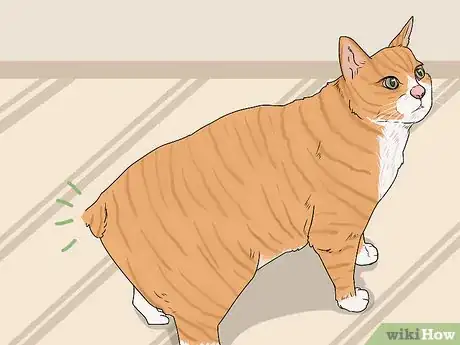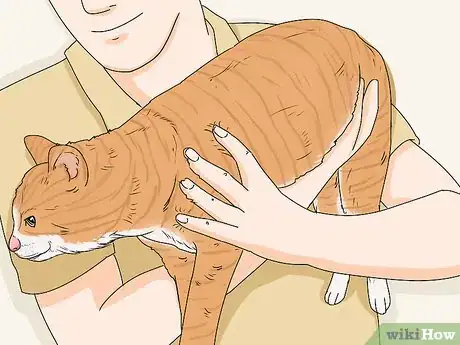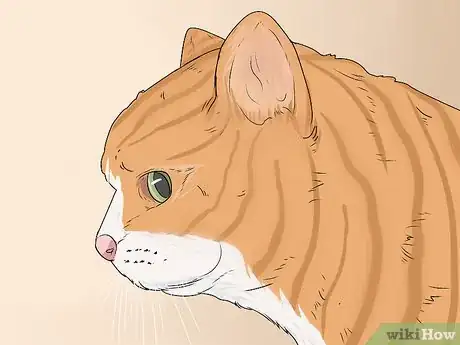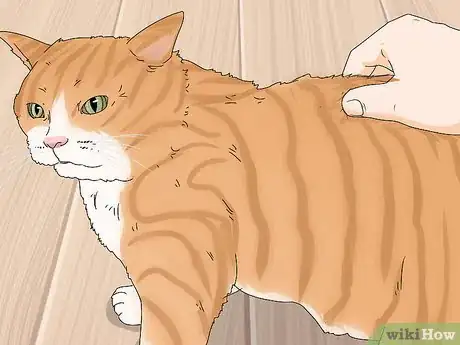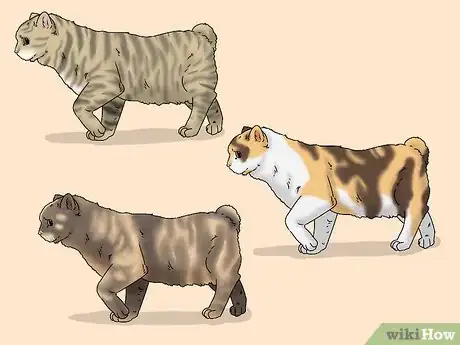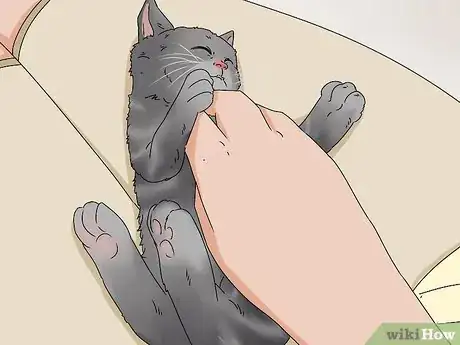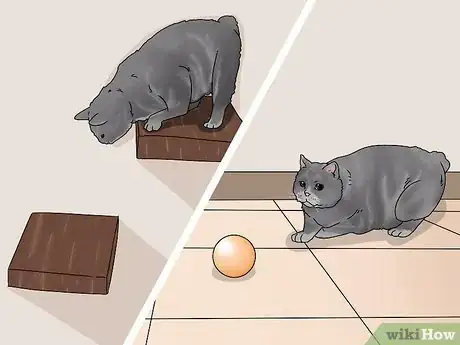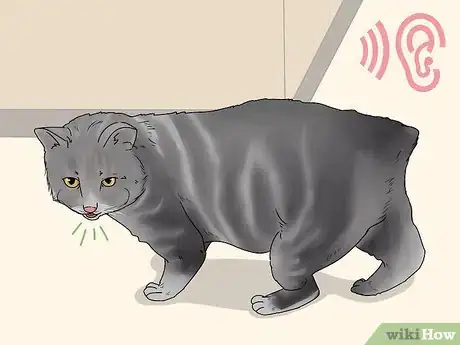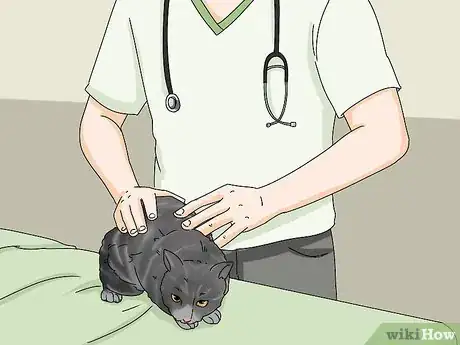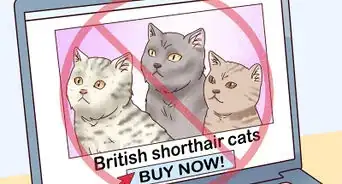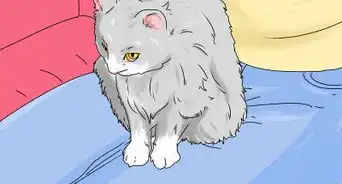This article was co-authored by Melissa Nelson, DVM, PhD. Dr. Nelson is a Veterinarian who specializes in Companion and Large Animal Medicine in Minnesota, where she has over 18 years of experience as a veterinarian in a rural clinic. She received her Doctor of Veterinary Medicine from the University of Minnesota in 1998.
There are 9 references cited in this article, which can be found at the bottom of the page.
This article has been viewed 77,172 times.
Manx are tailless cats that come from the Isle of Man in the Irish Sea, where they developed their taillessness centuries ago because of a genetic mutation.[1] The best way to identify a Manx is to analyze its physical features. Manx often have no tails, or only a stumpy tail. They have large eyes, a compact and sturdy build, and ears that appear to form a cradle-like shape when viewed from the rear. Behavioral clues are also helpful when identifying a Manx. They are playful and friendly, and produce a distinctive trilling sound.
Steps
Using Physical Traits to Identify a Manx
-
1Look at the tail. Manx cats have four different tail varieties. “Rumpies” have no tail at all, and instead sport a dimple at the base of the spine where the tail would normally extend. “Rumpy-risers” have a stubby tail of only one to three bones. “Stumpies” have a short tail that is curved or kinked. And finally, “longies” have tails that are almost as long as those of regular cats.
- Most breeders cut the tails off of longies, so unless you’re a breeder, you probably won’t encounter a longie.
-
2Look at the build. Manx cats are muscular and compact, with a sturdy skeleton. They are medium to large in size with a wide chest. Their hind legs are noticeably longer than their front legs, giving them an appearance some have likened to rabbits.[2]
- Males might be somewhat larger than females.
Advertisement -
3Check the head for a cradle-like shape. When viewed from behind, the ears appear as a cradle or rocker shape. The ears are broad-based and taper to a rounded tip.[3]
- Manx cats have broad faces.
-
4Touch the cat. There are two varieties of Manx coats. Short-haired Manxes have a long overcoat with a dense, fluffy undercoat. The hair of the overcoat might feel coarse even though it looks fluffy. If you pet the cat during summer or late spring, the fur might feel thin due to spring shedding. The long-haired Manx has a silky coat of medium length, and tufts of fur between its toes and around its ears.[4]
- White Manxes might have a softer coat than Manxes of other colors.
-
5Look for large eyes. Manxes have large, round eyes. The outer corners of the eyes will point up slightly toward the ears, while the lower corners will angle down and inward slightly toward the nose.[5]
- Eye color in Manxes varies. Green, hazel, gold, copper, and blue are all common. Some Manxes are odd-eyed (that is, each eye has a different color).
-
6Weigh your cat. Male Manxes weigh around 10-12 pounds (4.5-5.4 kg). Females weigh about 8-10 pounds (3.6-4.5 kg). Weigh your cat on a scale to determine if it falls within or near breed averages.[6]
- Manxes feel surprisingly heavy when lifted.
-
7Use color to identify the cat. Manxes come in a wide variety of colors, so using color to identify one can be difficult. Common colors include tabby, calico (multicolor), and tortoiseshell. You can eliminate certain colors, though, since Manxes do not come in chocolate, lavender, or pointed (light coloring on the body and dark coloring on the limbs, tail, and face) varieties. They also do not come in any of these colors plus white.[7]
Using Other Clues to Identify a Manx
-
1Look for a friendly demeanor. Manxes are playful and friendly animals. They are affectionate and love hopping in people’s laps. They get along well with children and other pets. If that sounds like your cat, you might have a Manx.
-
2Look for a playful cat. Manxes enjoy jumping on shelves and other elevated perches. They have dog-like characteristics that include chasing after balled-up pieces of paper or ping-pong balls. They also enjoy swatting at running water. If your cat comes running when you turn the tap, you might just have a Manx.
- If you do have a Manx, you can provide it with a cat tree or cat house so it can have many opportunities to jump and play.
-
3Listen to the cat. Manx cats do not vocalize often, but they do have a distinctive vocalization. In addition to normal feline purrs and meows, they also produce a trilling sound. This sound is most commonly heard from mother cats callings their kittens. Manxes have soft voices.[8]
-
4Monitor the cat’s health. Manxes have generally good health, but are predisposed to a condition called Manx syndrome. The condition has a number of symptoms that might not be immediately obvious as part of an underlying condition. Symptoms can include bowel and bladder issues, poor digestion, deformity of the spine, and partial paralysis. Manx syndrome is usually a lifelong condition that can cause serious pain and discomfort for Manx cats. [9]
- If you observe these symptoms in your cat, contact your vet for a diagnosis.
-
5Get a genetic test. If you cannot determine whether or not you’ve got a Manx on your hands using behavioral and visual data, you could take your cat to the vet for a DNA test. To perform a DNA test, your vet or a qualified medical technician will perform a noninvasive procedure to obtain a sample of your cat’s DNA, typically by swabbing the inside of its cheek or clipping some of its fur. The cat’s genome will then be matched against that of a known Manx cat and evaluated for similarities.[10]
-
6Find a reputable breeder. By obtaining your cat through a reputable breeder, you’ll be able to get official certification from the breeder that confirms whether your cat is a Manx. To identify reputable breeders, consult your vet or a feline enthusiast association such as the International Cat Association.[11]
References
- ↑ http://www.cfa.org/Breeds/BreedsKthruR/Manx.aspx
- ↑ http://www.fanciers.com/breed-faqs/manx-faq.html#description
- ↑ http://www.fanciers.com/breed-faqs/manx-faq.html#description
- ↑ http://www.sheppardsoftware.com/content/animals/animals/breeds/cat_manx.htm
- ↑ http://www.vetstreet.com/cats/manx#1_ugw20zmq
- ↑ http://www.fanciers.com/breed-faqs/manx-faq.html#description
- ↑ http://www.vetstreet.com/cats/manx#1_ugw20zmq
- ↑ http://www.fanciers.com/breed-faqs/manx-faq.html#description
- ↑ https://www.ufaw.org.uk/cats/manx-manx-syndrome
About This Article
To identify a Manx cat, check for a tail stump at the base of the spine, since these cats typically don't have tails. Next, look for a muscular and compact build with a sturdy skeleton. You can also check the cat's legs, since Manx usually have hind legs that are noticeably longer than their front legs. A cradle-like head shape and a broad face are also characteristics of a Manx. For tips on using behavior to identify a Manx, read on!
